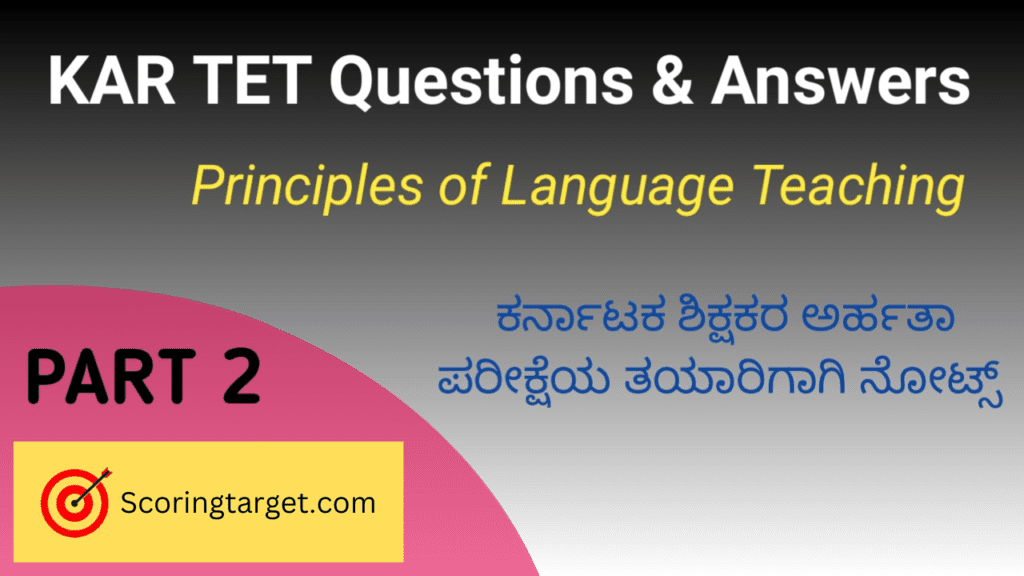KARTET questions and answers Part 2. Previous year questions and answer of KAR TET exam. Principle of language teaching notes for CTET.
In this post we are going to discuss principle of language teaching question and answer for Karnataka Teacher Eligibility Test (KARTET).
“Get ready for the KAR TET exam with our in-depth video on the principles of language teaching! Learn essential concepts and effective methods for teaching language to students.
From communicative approaches to classroom strategies, we cover key topics to help you succeed in the exam and beyond. Subscribe for more educational insights and boost your teaching skills!”
To get more video notes for KAR TET exam preparation notes, visit our YouTube channel. This channel is very useful for CTET exam preparation.

Principles of language teaching in english pedagogy
Principle of Language Teaching
(Previous Year Questions for KAR TET)
1. Which of the following is suitable for making students responsible for their own learning?
(a) Using technology to chat and network
(b) Encouraging students to ask more and more questions
(c) Giving a lot of homework, project work and assignments to improve language skills of students
(d) Discouraging students from making decisions about how they learn best
Answer: (b)
2. The Constructivist Approach to learning means
(a) teaching rules of grammar and consolidating through rigorous practice
(b) helping learners acquire new vocabulary by studying literature intensively
(c) teaching new words and structures using a variety of audio – visual aids followed by practice through drill
(d) involving the students in a variety of activities to encourage them to learn new words and structures by accommodating them with those that they have already learnt through a process of discovery
Answer: (d)
3. When learners are engaged in a pair activity, taking on roles of a doctor and a patient, the activity is called
(a) declamation
(b) simulation
(c) exchanging notes
(d) real activity
Answer: (b)
4. Gender stereotypes and bias among learners can be discouraged by
(a) using textbooks which do nor perpetuate such beliefs
(b) creating an open and encouraging atmosphere in a mixed class
(c) pressuring girls to learn cooking
(d) enabling all learners to cook and sew irrespective of gender
Answer: (b)
5. A child-centred classroom is characterized
(a) very passive teachers and active learners
(b) a variety of learning activities for the learners
(c) children sitting in the center of the classroom
(d) children teaching other children under the supervision of the teacher.
Answer: (b)
Previous year questions and answer of KAR TET
6. When a teacher uses lessons in Science and Social Science to teach language, such an approach can be termed as
(a) language across the curriculum
(b) objective language teaching
(c) pluralistic language teaching
(d) discipline – wise language teaching
Answer: (a)
7. After reading a story on fish, if a teacher asks children to answer. . . . “Imagine you are a fish in a pond. What do you see around you?” This is an example of
(a) multiple choice question
(b) comprehension question
(c) cloze type question
(d) open-ended question
Answer: (d)
8. Constructivist approach to language teaching expects the teacher to
(a) help construct knowledge using their experiences
(b) give pre – constructed knowledge to learners
(c) construct his own curriculum
(d) fake learners prepare their own textbooks
Answer: (a)
9. “You ask, what has my government done for you?
I can answer in two words: A lot!”
The question put here is
(a) Rhetorical
(b) A prompt
(c) Stylized
(d) Explanatory
Answer: (c)
10. ‘Gender sensitization’ in the school curriculum implies
(a) children should be differentiated as boys and girls
(b) sex education from primary school onwards
(c) respectful approach towards defining gender roles
(d) promote co – education in high school
Answer: (c)
11. The ‘question’ How will I achieve my teaching goal? In the design of a language instruction, which helps the teacher to ‘keep the lesson on target’ is/are the
(a) objectives
(b) methodology
(c) evaluation
(d) documentation
Answer: (a)
12. _______ is the particular way a learner prefers to learn a second or foreign language.
(a) Cognitive style
(b) Cognitive process
(c) Behaviorist approach
(d) Literal approach
Answer: (d)
Principle of language teaching question and answer
13. The focus is on using the language rather than analysis of the language and grammar is taught implicitly rather than explicitly.
(a) Direct approach
(b) Communicative approach
(c) Grammar – translation method
(d) Structural method
Answer: (b)
14. Constructivist approach to learning does not emphasize
(a) that authentic task in a meaningful context should be used
(b) teaching as the transmission of knowledge from the enlightened to the unenlightened
(c) that learners construct knowledge for themselves
(d) knowledge construction instead of knowledge reproduction
Answer: (c)
15. A learner – centered class should not be one where
(a) the learners should do the given exercise silently as silence is better for learning to occur
(b) the learner’s personal views and feelings are taken into consideration
(c) the learners are intrinsically interested and are inclined to explore
(d) the teacher acts more as another participant in the learning process
Answer: (a)
Watch this video for the explanation of KARTET questions and answers Part 2.
“Are you gearing up for the Karnataka Teacher Eligibility Test (KARTET)? Our channel is here to help you ace the exam! We offer expert insights, study tips, and practice questions to guide you through each step of your preparation.
From exam pattern breakdowns to key topics in education, we’ve got you covered. Subscribe and join us for a comprehensive journey toward KARTET success!”
Important links for TET Exam preparation
1. KAR TET study material (Videos)
